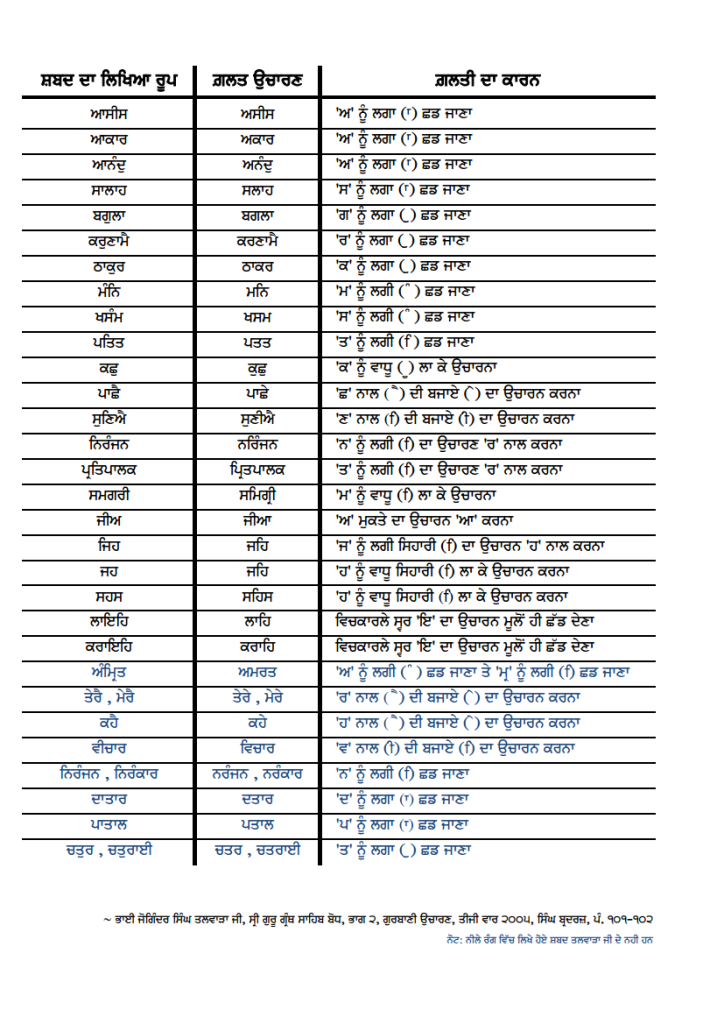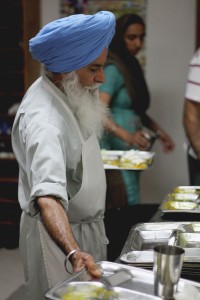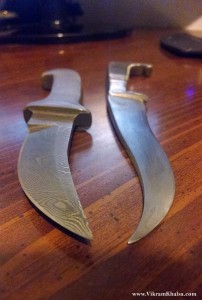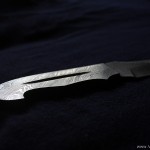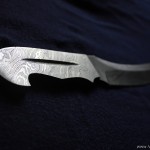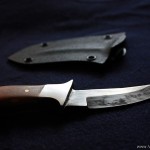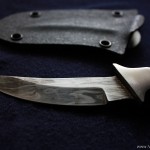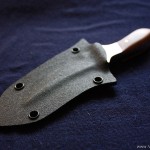3 Tips to Improve your Gurbani Pronunciation
Today I’d like to talk about 3 simple ways in which one could improve their Gurbani Ucharan. When we read Gurbani, its important to pay attention to the words and how they are spelled. A small mistake in pronunciation could change the meaning entirely, so we should try our best to be shud(clear) when reading Gurbani. Correct pronunciation is even more important when someone else is listening, because that small mistake on our part could cause a larger misunderstanding for the listener(s) since they cannot see the words themselves. If you have taken santhiya, hopefully you will already know these things and pay attention to them. If you haven’t, I hope you can learn from this article and improve. Either way, I hope everyone can find something useful here.
I’m not going to write about any complex topics in here like viakran(grammar), parts of speech, singular/plural, masculine/feminine etc. or controversial stuff like whether or not we should pronounce bindis and all that. These are just 3 simple tips that I think everyone across the board can agree on, no matter your background. I’m not an expert by any means, these are just basic things I have learned and observed over the years so I wanted to share them for everyone’s benefit. Each “tip” is followed by examples from common Nitnem baanis.
1) Know the difference between laav/laa and dulaava/dulaiya. This is very important and unfortunately one of the most common mistakes I hear everyday. People just don’t seem to know the difference, or they don’t care to pay attention. If you have taken santhia you should know that one makes an “ay” sound such as in “hay” or “bay” and the other makes an “ai” sound such as in “cat” or “mat”. Majority of the people I’ve heard read Gurbani mispronounce these and don’t differentiate between them I would like to very briefly narrate a sakhi here to explain the importance of this point. I’m sure you can find this saakhi online in much more detail if interested. But basically, once time Guru Sahib asked a sikh to recite Gurbani for him, and the sikh was doing a wonderful job and Guru sahib was very happy with him. Then he got to the line
ਕਰਤੇ ਕੀ ਮਿਤਿ ਕਰਤਾ ਜਾਣੈ ਕੈ ਜਾਣੈ ਗੁਰੁ ਸੂਰਾ ||੩||
karathae kee mith karathaa jaanai kai jaanai gur sooraa ||3||
Only the Creator Himself knows His own extent; or the Brave Guru knows. ||3||
But he pronounced kai as ke. Guru sahib stopped him right there and ordered sikhs to give him some sort of punishment (according to some accounts he was “caned” or slapped), because by saying “kay”, the meaning of the line changed from “…. or the Brave Guru knows” to “…what does the Guru know?”, meaning the Guru knows nothing. This seemingly small mistake translated into a huge insult toward Guru Sahib. Although I’m not sure how accurate this incident is because we know Guru Sahib is forever merciful, it still illustrates how important it is to pronounce Gurbani correctly, to the best of our ability.
More examples:
ਮੰਨੇ ਕੀ ਗਤਿ ਕਹੀ ਨ ਜਾਇ ||
ma(n)nae kee gath kehee n jaae ||
(Japji Sahib) Notice the first manae pauri in Japji Sahib uses Manae
ਮੰਨੈ ਸੁਰਤਿ ਹੋਵੈ ਮਨਿ ਬੁਧਿ ||
ma(n)nai surath hovai man budhh ||
(Japji Sahib) while the next 3 pauris use Manai. The difference is due to meaning.
ਕਹੈ ਨਾਨਕੁ ਅਨੰਦੁ ਹੋਆ ਸਤਿਗੁਰੂ ਮੈ ਪਾਇਆ ||੧||
kehai naanak ana(n)dh hoaa sathiguroo mai paaeiaa ||1||
Says Nanak, I am in ecstasy, for I have found my True Guru. ||1||
(Anand Sahib) Many people say Kahay, correct pronunciation is kahai.
ਸੁਣਿ ਕੈ ਜਮ ਕੇ ਦੂਤ ਨਾਇ ਤੇਰੈ ਛਡਿ ਜਾਹਿ ||
sun kai jam kae dhooth naae thaerai shhadd jaahi ||
Hearing Your Name, the Messenger of Death runs away.
(Rehraas Sahib) first one is kai, second is kay. They have different meanings.
ਸੁਣਿ ਵਡਾ ਆਖੈ ਸਭੁ ਕੋਇ ||
sun vaddaa aakhai sabh koe ||
Hearing of His Greatness, everyone calls Him Great.
(Rehraas Sahib) Many people say aakhay, correct pronunciation is aakhai.
ਤਿਤੁ ਸਰਵਰੜੈ ਭਈਲੇ ਨਿਵਾਸਾ ਪਾਣੀ ਪਾਵਕੁ ਤਿਨਹਿ ਕੀਆ ||
thith saravararrai bheelae nivaasaa paanee paavak thinehi keeaa ||
In that pool, people have made their homes, but the water there is as hot as fire!
(Rehraas Sahib) many people say Sarvarray, correct pronunciation is sarvarrai.
2) Know the difference between Siharee and Biharee. The former has is an I sound, such as in “bit” or kit”, while the latter has an ee sound such as in “beet, meet”. These are easy to overlook and people often say one in place of the other.
ਗਾਵਨਿ ਤੁਧਨੋ ਇੰਦ੍ਰ ਇੰਦ੍ਰਾਸਣਿ ਬੈਠੇ ਦੇਵਤਿਆ ਦਰਿ ਨਾਲੇ ||
gaavan thudhhano ei(n)dhr ei(n)dhraasan bait(h)ae dhaevathiaa dhar naalae ||
Indra, seated on His Throne, sings of You, with the deities at Your Door.
(Japji Sahib) Many people say devteeaa, correct pronunciation is devtia.
ਗਾਵਨਿ ਤੁਧਨੋ ਸਿਧ ਸਮਾਧੀ ਅੰਦਰਿ ਗਾਵਨਿ ਤੁਧਨੋ ਸਾਧ ਬੀਚਾਰੇ ||
gaavan thudhhano sidhh samaadhhee a(n)dhar gaavan thudhhano saadhh beechaarae ||
The Siddhas in Samaadhi sing of You; the Saadhus sing of You in contemplation.
(Japji Sahib) Many people say bichaaray, correct pronunciation is beecharay.
ਮੋ ਰੱਛਾ ਨਿਜ ਕਰ ਦੈ ਕਰਿਯੈ ||ਸਭ ਬੈਰਨ ਕੋ ਆਜ ਸੰਘਰਿਯੈ ||
mo raashhaa nij kar dhai kariyai ||sabh bairan ko aaj sa(n)ghariyai ||
Give me Your Hand and protect me. Destroy all my enemies today.
(Chaopei Sahib) We often hear kareeyai and sanghareeyai, correct pronunciation is kariyai, sanghariyai.
ਦੇਹ ਨਿਮਾਣੀ ਲਿਵੈ ਬਾਝਹੁ ਕਿਆ ਕਰੇ ਵੇਚਾਰੀਆ ||
dhaeh nimaanee livai baajhahu kiaa karae vaechaareeaa ||
The body is dishonored without devotional love; what can the poor wretches do?
(Anand Sahib) We often hear vecharia, correct pronunciation is vechareea.
ਥਾਲ ਵਿਚਿ ਤਿੰਨਿ ਵਸਤੂ ਪਈਓ ਸਤੁ ਸੰਤੋਖੁ ਵੀਚਾਰੋ ||
thhaal vich thi(n)n vasathoo peeou sath sa(n)thokh veechaaro ||
Upon this Plate, three things have been placed: Truth, Contentment and Contemplation.
ਅੰਮ੍ਰਿਤ ਨਾਮੁ ਠਾਕੁਰ ਕਾ ਪਇਓ ਜਿਸ ਕਾ ਸਭਸੁ ਅਧਾਰੋ ||
a(n)mrith naam t(h)aakur kaa paeiou jis kaa sabhas adhhaaro ||
The Ambrosial Nectar of the Naam, the Name of our Lord and Master, has been placed upon it as well; it is the Support of all.
(Rehraas Sahib) We often hear people pronounce them both the same way, but they are both pronounced differently.
ਜਿਨ ਕਉ ਲਗੀ ਪਿਆਸ ਅੰਮ੍ਰਿਤੁ ਸੇਇ ਖਾਹਿ ||
jin ko lagee piaas a(n)mrith saee khaahi ||
Those who feel thirst for You, take in Your Ambrosial Nectar.
(Rehraas Sahib) Most people say “Say-ee”. but its actually “say-i”.
ਰਖੇ ਰਖਣਹਾਰਿ ਆਪਿ ਉਬਾਰਿਅਨੁ ||
rakhae rakhanehaar aap oubaarian ||
O Savior Lord, save us and take us across.
(Rehraas Sahib) We often hear ubareean. The whole pauri has siharees, so correct pronunciation is ubarian, savarian
3)Pause between words. I learned this from my Dad and I’ve never heard any one else mention it, but it makes quite a difference. When one word ends with a certain letter and the next word starts with the same letter, if we speak too fast we tend to blur the words together into one word. However, if we pause even for a short amount, there is a clear space and the letters are pronounced separately. Examples:
ਸਹਸ ਸਿਆਣਪਾ ਲਖ ਹੋਹਿ ਤ ਇਕ ਨ ਚਲੈ ਨਾਲਿ ||
sehas siaanapaa lakh hohi th eik n chalai naal ||
Hundreds of thousands of clever tricks, but not even one of them will go along with you in the end. (Japji Sahib)
ਜੇ ਹਉ ਜਾਣਾ ਆਖਾ ਨਾਹੀ ਕਹਣਾ ਕਥਨੁ ਨ ਜਾਈ ||
jae ho jaanaa aakhaa naahee kehanaa kathhan n jaaee ||
Even knowing God, I cannot describe Him; He cannot be described in words. (Japji Sahib)
ਪੰਚੇ ਸੋਹਹਿ ਦਰਿ ਰਾਜਾਨੁ ||
pa(n)chae sohehi dhar raajaan ||
The chosen ones look beautiful in the courts of kings. (Japji Sahib)
ਪੰਚ ਦੂਤ ਤੁਧੁ ਵਸਿ ਕੀਤੇ ਕਾਲੁ ਕੰਟਕੁ ਮਾਰਿਆ ||
pa(n)ch dhooth thudhh vas keethae kaal ka(n)ttak maariaa ||
Through You, we subdue the five demons of desire, and slay Death, the torturer. (Anand Sahib)
ਜਿਨ ਨਰ ਨਾਮ ਤਿਹਾਰੋ ਕਹਾ ||ਦਾਰਿਦ ਦੁਸਟ ਦੋਖ ਤੇ ਰਹਾ ||੨੪||
jin nar naam thihaaro kehaa ||dhaaridh dhusatt dhokh thae rehaa ||24||
One, who repeats Your Name, Will be relieved from poverty and saved from attacks of foes. (Chaopei Sahib)
ਹੂਜੋ ਸਦਾ ਹਮਾਰੇ ਪ੍ਨਛਾ || ਸ੍ਰੀ ਅਸਿਧੁਜ ਜੂ ਕਰਿਯਹੁ ਰ੍ਨਛਾ ||੫|| ੩੮੧||
hoojo sadhaa hamaarae paashhaa || sree asidhhuj joo kariyahu raashhaa ||5|| 381||
Remain always on my back. Protect me, a graceful (Lord) with sword on Your Banner! (Chaopei Sahib)
ਹਰਿ ਰਾਸਿ ਮੇਰੀ ਮਨੁ ਵਣਜਾਰਾ ||
har raas maeree man vanajaaraa ||
The Lord is my capital; my mind is the merchant. (Anand Sahib)
ਸੁਣਤੇ ਪੁਨੀਤ ਕਹਤੇ ਪਵਿਤੁ ਸਤਿਗੁਰੁ ਰਹਿਆ ਭਰਪੂਰੇ ||
sunathae puneeth kehathae pavith sathigur rehiaa bharapoorae ||
Pure are the listeners, and pure are the speakers; the True Guru is all-pervading and permeating. (Anand Sahib)
Just paying attention to these three things will force you to focus on what you’re reading and help keep your mind from wandering. As we implement these tips our Gurbani pronunciation will become clearer and more understandable. They can also help us when trying to read Larrivaar Gurbani (the original form where words are written without spaces in between). At the same time let us not forget that the most important aspect of all is reciting with love. May Guru Sahib accept our best effort and forgive all our mistakes.
Waheguru Ji Ka Khalsa Waheguru Ji Ki Fateh!
-Vikram Singh
—–Update 3/23/2016—–
I just wanted to add this image I found containing a list of common gurbani pronounciation mistakes from a Gurbani Ucharan book written by Bhai Joginder Singh Talwara Jee. I think a lot of people might find it useful.
Posted in Sikhi and tagged baanee, baani, banee, gurmat, keertan, khalsa, kirtan, pronounciation, punjabi, sikh, sikhism, vaheguroo, veechar, vichar, waheguruwith no comments yet.
Degh Fateh: The Unsung Heroes
Ever since I can remember, I’ve been sitting on Gurdwara stages with my father – playing tabla, harmonium, or crying in my mother’s lap. Appearing on stage often meant we were constantly under the spotlight and given plenty of attention from sangat. Uncles and aunties frequently came up to me to give compliments on my tabla playing, since I was so young. Almost everyone knew who we were, and many people would meet or greet me with love because I was the son of a Bhai Sahib. We were constantly given respect by the sangat, due to our being at the forefront of the scene.
But today I would like to focus on someone else. Not the committee members, kathavachaks, or famous Raagis (all whom deserve respect and play vital roles in the Panth and Gurdwara ecosystem). Rather, today I would like to discuss the people who are left in the background. The average Joe (or Jeet) who spends hours doing seva but doesn’t get any fame, respect, or recognition. For the longest time, I took for granted just how complex it was to run the Langar in just one Gurdwara. Countless volunteers joining together to feed the sangat, with no personal gain in mind – now that is true selfless service. Every time I visit the Langar Hall, I see so many different faces – all pegs in this giant wheel, turning and churning to continue the operation of Langar. Just normal, random people, making rotis, washing dishes, rolling dough, setting plates and serving food. People of all ages, from little boys to old women and everyone in between.
The sevadaars who serve food in the Langar line are visible to the sangat, but the people washing dishes or cleaning are often hidden in the back. We all eat and put our dishes away, but how often do we think about what happens next? How would the system work without all of these people doing their part? Have we ever stopped and thought, if there weren’t enough volunteers, how would the dishes get washed?
On random days of week, at odd hours of the night, you can find people there, ever ready to serve. It amazes me that there is always someone who sees a pile of dishes and decides to take out his or her time to do something about it. The necessary tasks somehow always gets done, relying on random sevadars to come do them. There are times when no one is taking care of a seva and other times when there are so many volunteers that there is no space to join them! From dumping trash to mopping the floors, the Sikh spirit of seva is still alive. Seeing it always fills me with happiness and inspiration. These are the real heroes, wonderful selfless sevadars without whom the whole system would collapse!
It never fails to amaze me how random and mixed the group of volunteers is. They’re not all amritdhari or even kesadhari. Countless people who don’t fit the typical “Gursikh” image are always doing seva, vacuuming, rolling rugs, being involved and helping out. These people deserve the real praise and recognition. This is not the same as getting time on stage and showing how fancily you can play harmonium, how vocally skilled you are or what bols you can play on a tabla, activities which are usually followed by praise or compliments. In fact, most of the background sevas don’t come with any credit or recognition. There is a reason Guru Gobind Singh Ji told Bhai Nand Lal to wash the dishes of the Khalsa, why Gursikhs often advise us to dust the shoes of Sangat. Sevas like these are meant to keep us humble.
Whatever our motivation may be, ego usually tries to poke its head in. That’s why many people try to do seva in private. To be honest, I often face an internal struggle between not wanting anyone to see me while at the same time secretly hoping someone will! It’s tough not to become egotistical once you start doing a lot of seva. Something that is supposed to create a sense of humility can also give rise to more ego. In order for it to be truly fruitful, it is important for seva to be done without ulterior motives or expectation of rewards. It is even more beneficial if one were to do Simran at the same time.
I always wondered, what is the motivation and drive behind it? Why do people do it? And let me tell you, the only way to find out is by trying it yourself. It’s an amazing feeling, standing side by side with a stranger, with the same purpose and goal: to be one of many in this huge effort. No obligations, no expectations. I can say from personal experience that the feeling of peace and contentment you get doing seva is incomparable. Just knowing that you are doing something, however small, is satisfying. The contentment and sense of purpose I get from it is just.. I’ve never felt that anywhere else. And I’ve barely done any seva in my entire life!
Now, getting to the title of this post:
We’re all familiar with the famous Sikh Slogan “Degh Tegh Fateh”. Notice that the word “Degh” comes first. The Degh part is just as important to victory as the sword, or the warrior (sipahi) spirit. This means victory to the “cooking pot”, representing the concept of feeding and serving the community, making sure everyone is well fed in addition to providing protection and being politically victorious.
Over 500 years ago, Guru Nanak Dev Ji made the best investment of all time with only 20 rupees. To this day, that true bargain is paying off for the thousands who are getting fed around the world through the institution of Langar. If that’s not a good deal then I don’t know what is! People in all parts of the world are sitting together like equals and eating meals every single day, for free, all thanks to Dhan Guru Nanak Dev Sahib Ji.
 Those who kept the Langars going and kept the Khalsa Army fed played a vital role in our Panth’s history. I say unsung heroes because we tell tales and sing ballads about the bravery and valor of our heroes who wielded the sword, but what about those selfless Sikhs who fed and served the Khalsa? The Sikhs who did seva in the Langar, like Bhai Manjh? Who sacrificed their families, comfort and personal health for the Guru’s institution of Langar? Sikhs like Bhai Taru Singh who gave up their lives for the Khalsa? For the amazing Khalsa Langar, where royalty and highly educated people like Bhai Nand Lal washed away their egos and purified their mind. That same Langar where emperors had to come sit at the same level as common people. Dhan Guru Ka Langar which even the enemy was welcome to come partake in!
Those who kept the Langars going and kept the Khalsa Army fed played a vital role in our Panth’s history. I say unsung heroes because we tell tales and sing ballads about the bravery and valor of our heroes who wielded the sword, but what about those selfless Sikhs who fed and served the Khalsa? The Sikhs who did seva in the Langar, like Bhai Manjh? Who sacrificed their families, comfort and personal health for the Guru’s institution of Langar? Sikhs like Bhai Taru Singh who gave up their lives for the Khalsa? For the amazing Khalsa Langar, where royalty and highly educated people like Bhai Nand Lal washed away their egos and purified their mind. That same Langar where emperors had to come sit at the same level as common people. Dhan Guru Ka Langar which even the enemy was welcome to come partake in!
It really humbles me to see kids, couples, families, and seniors on random days all cleaning the dishes. The feeling they get upon seeing a pile of unwashed plates, with no one there washing them, that feeling of shared responsibility, that, “Yes, I want to do something, to contribute, to make a difference.” The thought that “I’m willing to stick my hands in a sink full of yellow water and people’s leftovers rather than go home 15 minutes early.” It is very inspiring. It gives me hope. There is something glorious about it.
These are real heroes that we don’t acknowledge. But then again, maybe that’s what makes it special. There is something magical about coming outside and seeing all the shoes arranged in a neat line without knowing who did it. Perhaps recognizing these people and giving them awards would ruin it and take it all away. If you do these sevas, I salute you. If you truly serve, selflessly, I respect you. You are hundreds of times better than me and perhaps many others who preach from stages. And if you don’t, you should try it sometime. It’s an amasingh feeling.
Posted in Sikhi and tagged culture, food, gurdwara, khalsa, kitchen, langar, selfless service, seva, sikhi, sikhswith 2 comments.
[Review] Khalsa Armory Kirpans
The Kirpan is often translated as a “Sikh Ceremonial Dagger”, but it is a whole lot more than that. It does have a lot of spiritual significance, but it is also meant to be practical and usable, if the need arises. As something a Sikh is supposed to carry on their person at all times, the Kirpan should be a high quality shastar, not the mass produced sheet of metal cut into a Kirpan shape that we often see today.
Allow me to introduce Khalsa Armory. Started by a young Singh from the Fresno area, KA describes itself as “A Knife & Arms company founded on 3 solid values. Q.U.A. ; Our products will show Quality, Uniqueness & Affordability!“. Today I will evaluate how well this statement holds up under closer scrutiny. I had the opportunity to check out the KA stall at the Yuba City Nagar Kirtan and take home a few pieces to test out. Let me briefly describe the 4 test models I got to spend time with and then I can discuss what I thought of them.
DK-2 – KA’s original flagship product ( the DK-1) wasn’t available when I got the review units, so I’m taking a look at the DK-2, which is the next closest thing. The main difference here is that that the DK-1 is a solid 1 piece Kirpan in which the handle is made of the same metal as the blade. The DK-2 has micarta grips on the sides of the handle which makes it lighter in weight and lower in price.
DK-3 – The DK-3 is a slimmed down version of the DK-1, where the handle has been cut down in width. So overall the Kirpan is lighter, and has a slimmer profile. The blade also has a tapered curve towards the back edge, which gives it a really cool sleek look. However, the slimmer handle doesn’t feel as nice in the hand due to its sharper edges.
DK-4 – A smaller sized Kirpan, the DK-4 is a single piece design, similar to a Taksali or traditional Kirpan with the smaller rounder handle. Sort of like a mini DK-1, it has a nice feel in the hand and nice blade as well.
DK-5 – Another smaller model, the DK-5 sports a small but beautiful wood-like handle. It is harder to hold on to if you were actually cutting something, but it can be carried daily or kept on the person, since the handle isn’t too top heavy. The blade is nice and sharp and features a beautiful design.
Photo Credit: Ikonkar Kaur Jan 2014.
Quality: 8/10
There is no doubt as to the quality of these Kirpans. The workmanship that went into them is apparent as soon as you pick one up. They are very well made, and the subtle design elements really show the creator’s attention to detail. I’ve seen Khalsa Armory get to where it is today so I know that it went through a few iterations before they released this design as their standard. I’m confident that these Kirpans will last, and I’m sure they could take on any task thrown at them. The Damascus blade is made from different layers of steel folded together, resulting in a very strong and sharp Kirpan. They are definitely better quality than the mass produced Indian or Chinese “Kirpans”. Although not as fancy or complex as some others, the kydex sheaths do a great job of protecting the blade. The Kirpan won’t fall out or get stuck in one – it takes just the right amount of pull to slide it out.
Affordability: 7/10
I would say that these Kirpans are relatively affordable. While they are much more expensive than the average cheap Kirpans from India, they are also significantly better in terms of quality. In my opinion, the price difference is worth it – I would rather depend on a KA Kirpan than one of those. The Kirpans from Khalsa Armory are much closer to the price range of Taksali Kirpans (outside of India). However, in comparison to most other fancy artisan Kirpans (such as Khalsa Kirpans) they are much cheaper by far. A quick round at Yuba City Nagar Kirtan will show you how expensive nice fancy Kirpans can get, and KA ends up on the affordable side of the spectrum. It is important to note, however, that these do have simple sheaths as opposed to the intricately designed scabbards of some more expensive Kirpans, which may be engraved, embedded with previous stones or covered with expensive materials such as silver or gold.
Uniqueness: 9/10
These Kirpans are definitely unique. The single piece design and curve of the blades is different from both the traditional Kirpans we see and western knives as well. I would put the design somewhere in between – its like a western style blade with a Kirpan-like curve. The Damascus mixture of metal layers isn’t seen often these days and the swirly design is beautiful. Each Kirpan has a unique pattern, and the intricate etchings, cuts and patterned handles give these Kirpans their own personality. The blade covers also make these Kirpans stand out from others, since we never really see Kirpans with tactical sheaths. The handle shape is also different from many other Kirpans, as is the feel, size and weight.
Final Thoughts:
Khalsa Armory Kirpans are really really nice. Their blades are relatively sharp and much stronger than typical Kirpan blades. Whereas traditional Kirpan blades are thick at the back edge and gradually taper off into the blade, these blades are thick for about half the width of the blade, after which they slowly slope down to a sharp edge. Depending on the material, this added thickness plus the pattern and curve of the blade can make it harder to cut something. But the blade also has enough strength to push all the way through a tough material. I found them to be just a little sharper than my fairly well sharpened Taksali style kirpan. I personally wouldn’t wear any of these as my daily Kirpan because the blade is made of a mix of metals rather than Sarbloh (or what we call Sarbloh today), and because they are quite heavy. The top heavy design means they will tilt forward a lot in the Gatra. The sheath also has its pros and cons – being wider and flatter means sharper edges and an awkward Gatra fit, but they are also flatter against your body and there is no protruding tip (less damage to clothes and hard to poke yourself). All of that being said, I would definitely wear this Kirpan over the top – it not only makes for a beautiful display piece but it is a usable Shastar as well.
At the end of the day, Khalsa Armory Kirpans offer a beautiful design combined with solid quality at a fair price. I would definitely recommend these to anyone interested, whether its for a collection or to wear. They make a lot of other cool stuff including carbon fiber and titanium Shastars, and I’m always looking forward to their future products. For a limited time they are offering FREE SHIPPING with the coupon code “KAVSK”!
Check them out at : www.khalsaarmory.com or https://www.facebook.com/KhalsaArmory
Posted in Sikhi, Stuff and tagged custom, gift, khalsa, sikh, singhwith no comments yet.
Top 6 Gurbani Apps for Android
Update: Since this is one of my most popular posts – I wanted to let all the readers know about a new and more up to date resource for Gurbani apps and Sikh Tech in general – the Sikho Youtube channel. This channel will have videos, tutorials, guides and reviews for Sikh apps, websites, and resources and highly recommend you check it out. Feel free to continue reading the post below but know that the information may be a little outdated, although still valuable.
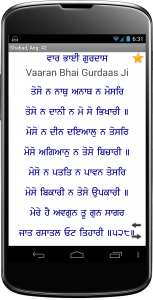 Although they cannot provide the same experience as using an actual Gutka or doing paath from a physical saroop of Sri Guru Granth Sahib Ji, smartphones and modern devices allow us to read Baani or sing shabads anytime, anywhere. They come in handy for kirtan when a projector system is not available, both for the kirtanee and sangat. There have been some great apps developed for iOS, and with the increasing popularity of the Android platform, many more Gurbani apps are becoming available – each with its own share of unique features. In this article I will be reviewing the 6 best Gurbani Search apps available on the Google Play Store. Each app is described along with a basic run down of its features, pros/cons, and screenshots. The Play Store links are included, so you can read the official descriptions and download them directly.
Although they cannot provide the same experience as using an actual Gutka or doing paath from a physical saroop of Sri Guru Granth Sahib Ji, smartphones and modern devices allow us to read Baani or sing shabads anytime, anywhere. They come in handy for kirtan when a projector system is not available, both for the kirtanee and sangat. There have been some great apps developed for iOS, and with the increasing popularity of the Android platform, many more Gurbani apps are becoming available – each with its own share of unique features. In this article I will be reviewing the 6 best Gurbani Search apps available on the Google Play Store. Each app is described along with a basic run down of its features, pros/cons, and screenshots. The Play Store links are included, so you can read the official descriptions and download them directly.
Being an Android user myself, I’m so glad that these apps are available and I want other users to be aware of them too. Most of them have been developed individually or by small groups, and they are all free. So a huge thanks to all of the developers who did this great seva and provided the sangat with a wide range of resources – I’m sure everyone can find something that fits their needs.
6. Sikhitothemax
By: Singh
Size: 153 kb (App downloads database separately)
Download
Android users may often download this app because of its well established name. However, there is nothing which says this app was developed by the same team that created the desktop software and website SikhiToTheMax. Rather, it seems that this was a private effort. When opening the app, it takes you straight to the search screen which has a Gurmukhi keyboard with nice large buttons that are clearly readable. The “first letters” search function works well, but it only searches Baani of Sri Guru Granth Sahib Ji; there are no results from Dasam Granth Sahib or Bhai Gurdas Ji’s Vaars. In shabad view, the app lets you go to the previous and next shabads. This is handy, although I wish the buttons at the top weren’t so big as they take up a lot of space from the screen. The layout is clean and clear. Settings are accessible from both the search page and Shabad view (by pressing your phone’s menu button), and include some great features such as light/dark backgrounds, different font options, and the ability to toggle the English translations. Overall this is a solid app that gets the job done, but lacks many of the advanced features that are available in other android apps.
Pros: Gurmukhi keyboard, adjustable font size, light/dark themes, hide/enable english, in-shabad menu access
Cons: delete button clears all letters – have to start again, no Dasam Bani or Bhai Gurdas, no favorites, no Baani or Granth view
5. Dhur Ki Baani
By Khalsa
Size: 6.24 mb
Download
This app has been available for a long time, and it provides a solid set of features. Upon opening the app, users are greeted with a simple home screen that has 3 options: Sikh Prayers, Search By Ang, and Search By Shabad. This app features a basic Nitnem Gutka built in, with the 7 daily Baania and Ardaas. The cool thing is that everything has English transliteration as well, so if you can’t read Gurmukhi you can still do paath. All the font sizes are adjustable as well. The search by ang feature is great too, if you know the ang number in SGGS you can just go right to it. The Search by Shabad option works well, with the usual first letters mechanism. However, you must type with your standard English keyboard and the letters appear in English. The other annoying thing is that you have to put spaces between the letters, unlike most other apps. The app only searches SGGS and does not include other sources such as Bhai Gurdas Ji or Dasam Bani. You can save a Shabad as a bookmark and view it later, and you can also conveniently take a screenshot with a special button right in the app. The app lets you navigate to the previous and next Shabads. There is a settings menu that you can access from the home screen, but if you are viewing a Shabad, you have to go back to the home page to change settings and then search for the Shabad again. Although the design looks a little bit outdated, this app is a great effort and works well.
Pros: Adjustable font size, toggle-able transliteration and translations, bookmarks, sreenshot, Nitnem Guttka, Search by Ang
Cons: No Dasam Baani or Bhai Gurdaas Ji, Menu only accessible from home, need spaces in search, English keyboard, English letters
4. iGranth
By: Richipal Singh
Size: 11.88mb.
Download
This was my favorite Gurbani search application for a really long time, and I still recommend it. The interface is clean, simple, and right to the point. Opening the app takes you right to the search screen, which has a Gurmukhi keyboard. The keys are big but the letters are very small, and people often have trouble reading them. But the ‘first letters anywhere’ search works pretty well. There is no menu or settings page – however, pressing the menu button in shabad view gives you the option to turn English translations on or off, or go straight to the corresponding SGGS page. The SGGS page viewer lets you navigate to any ang. You can also favorite the Shabads and access them later on. You can zoom in and out from the shabad view, which is very convenient. Some shabads have Punjabi viakhia but not all, for some reason. This app also includes a simple Nitnem Gutka that has the basic daily Baanis. The best thing about this app is that it also searches Dasam Baani, Bhai Gurdas Ji’s Vaaraa and even Bhai Nand Lal Ji and other compositions that are in Amrit Kirtan (Bhai Gurdaas Gingh, Rehitnamas, etc). All in all, a great app and usually my go-to choice.
Pros: Ability to zoom in shabad pages, turn off translations from page, favorites, share feature, Nitnem Gutka, go to ang, Gurmukhi keyboard, many compositions
Cons: Small Keyboard, no transliteration, can’t rearrange favorites, can’t change background or font color, punjabi translations incomplete
3. Gurbani Nirvaan
By: Vayu Waves
Size: 315 kb (App downloads database separately)
Download
I don’t use this app very often, but it actually has a lot of features, many of which are not available in other apps. The app’s home screen greets you with a random Shabad every time, which is great. If you look around you won’t find anything – you have to press the menu key in order to get some options (an older design style). You can read the full text from SGGS, Bhai Gurdas Ji, Dasam Granth, and a few specific Baania, and navigate within them by swiping left or right to change pages or go directly to a specific ang. The app also remembers the last place you left off so you can continue reading from there. There is a basic Nitnem Gutka that includes the standard daily Baanis. Whats great about the search function in this app is that you can search from first letters in Gurmukhi or English, and you can search for Gurmukhi words/phrases AND you can search for words in the English translation! It can search from SGGS, Dasam Bani, or Vaaran Bhai Gurdaas – but you have to select which source to search in. The most powerful feature of this app, in my opinion, is bookmark management. You can create different groups to put the bookmarks into, and change the order in which they appear. You can even edit the name of each bookmark to make it easier to find later on. Another unique and super cool feature about this app is that you can “pin” a Shabad to your home screen. So basically you can have a shortcut on your home screen that takes you directly to the Shabad you want, instead of trying to find it later – making it great for Kirtanis! This app may not be for everyone, but it has much to offer!
Pros: Dasam Granth & Bhai Gurdaas, Nitnem Gutka, word/english search, organized bookmarks, pin to homescreen, share
Cons: English keyboard, aged UI, need to select source when searching.
2. iSearch Gurbani
By: Gatway to Sikhism foundation
Size: 4.7mb (App downloads database separately)
Download
This app is strikingly similar to Gurbani Nirvaan. The home page once again shows a random shabad, and although the design is a little more aesthetically pleasing, it still uses the older menu paradigm. You won’t see any options until you press the menu button. You can read SGGS, navigate to any ang, swipe left and right to move forward or back, and you can zoom from within the shabad, so you don’t need to go into the menu. The Sundar Gutka/Baani list is very extensive and includes a lot more options than most of the other apps, including most of the Baanis in SGGS and some from Dasam Baani. This app also has Hindi and Romanization in addition to Gurmukhi and English translations. All the fonts sizes are adjustable and you can even pick some fancy Gurmukhi fonts, as well as change the background style. The search feature searches SGGS, Bhai Gurdaas, Dasam Bani and more all at once. But you have to remember to put spaces between the letters otherwise it won’t work. This apps lets you search using first letters or full words in english or in the transliteration. You can also save the shabads as favorites. The app also installs a gurmukhi keyboard in your phone that you can switch to make it easier for typing searches, but its annoying having to switch keyboards every time you use the app. Overall a very functional app that is also beautiful.
Pros: Hindi, English Transliteration, Sundar Gutka, go to ang, swipe and zoom from page view, adjustable font options, favorites, light/dark themes, searches all sources, includes gurmukhi keyboard, help menu
Cons: Need to put spaces between letters, separate Gurmukhi keyboard – need to switch input methods.
1. Gurbani Searcher
By: Surinder Pal Singh Bindra
Size: 21.99 mb.
Download
I have to admit, this is my favorite Gurbani App. I think its unmatched in the amount of features and the developer keeps updating it and making it better! As soon as you open the app there is a message saying Fateh and reminding users to cover their head to respect Gurbani. You can search with first letters anywhere or by individual words. The search is live, so the results start showing up as you type. There is a little icon that tells you what source the result is from. Unfrotunately the app doesn’t have a Gurmukhi keyboard built in, but the developer has one available to download separately. One of the best features of this app that others lack is pinch to zoom, the most intuitive way to change your text size. The author recently added a great menu that you can access by sliding from the left in shabad view, which lets you toggle English and Gurmukhi translations, as well as Hindi. An awesome unique feature is the auto-scroll, which scrolls the shabad down on its own. You can even adjust the speed, making it handy for following along Akhand Paath without the need to constantly touch your phone and scroll. You can save shabads to favorites, and then sort the favorites by raag, author, or even custom tags that you set . This can be very useful for kirtanees to organize their shabads into groups. You can also read SGGS, Bhai Nand Lal Ji, Bhai Gurdaas, Dasam Granth, and other compositions. The included Sundar Gutka has a wide selection of Baanis. You can view the Baani in scroll view or page view, which lets you turn pages in 3d. Other great features include live kirtan streaming, calendar, and exporting favorites. I think this is the most feature rich Gurbani App and it is designed well too.
Pros: Pinch to zoom, slide out menu, punjabi teeka & translation, hindi, recent history, sortable favorites, customize fonts and colors, hindi, live search, sundar gutka, page turning, auto scroll, bhai nand lal ji/rehit nama/compositions, calendar, kirtan, Larivar
Cons: no English transliteration, large app size, need to download Gurmukhi Keyboard separately
Well, those are the best Gurbani Search Apps I’ve found, seen, and used on Android devices. Thanks once again to all the developers and I hope readers found this article helpful. Go ahead and try a new app, you may end up liking it. There are a few great apps I left off of this list because they don’t fit the criteria for comparison (but they may be mentioned in a later article). Whats your favorite Sikhi app? If you have any other ideas, suggestions, or something I missed, please let me know in the comments below. Lets try to use these valuable resources and technology to connect more with our Guru!
Not using Android?
For iOS gurbani apps, check out this great post by Maneetpaul Singh:
http://www.maneetpaul.com/blog/2014/8/28/sikh-apps
Posted in Sikhi and tagged applications, banee, bani, dasam, granth, gurbani, gurmukhi, guru, gutka, kaur, keertan, khalsa, kirtan, mobile, nitnem, platform, sahib, sikhi, sikhism, singh, softwarewith no comments yet.
